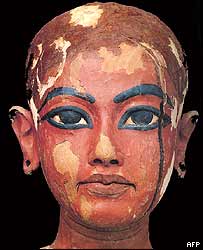Scientists have carried out the first
facial reconstructions of Egypt's most famous ancient king,
Tutankhamun.
Three teams of forensic artists - French, Egyptian and
American - built separate but similar models of the king's
face using scans of his skull.
The French and Egyptians knew who they were recreating,
but the Americans were not told where the skull came from.
The models of the boy king, who died 3,300 years ago,
reveal a young man with plump cheeks and a round chin.
Childhood image
The models bear a striking resemblance to the mask which
covered the mummified face of King Tutankhamun when his
remains were found by archaeologist Howard Carter in 1922
and other ancient portraits.
"The shape of the face and skull are remarkably similar
to a famous image of Tutankhamun as a child where he was
shown as the sun god at dawn rising from a lotus blossom,"
said Zahi Hawass, Secretary-General of the Egypt's Supreme
Council of Antiquities.

The US team
were not told where the skull came from
|
Using high-resolution photos of the CT scans,
the US team correctly identified the skull as coming from a
North African.
A CT, or "Cat", scan involves the use X-rays to map the
body.
The Egyptian team was able to work directly from the
scans, which could distinguish different densities of soft
tissue and bone.
"The results of the three teams were identical or very
similar in the basic shape of the face, the size, shape and
setting of the eyes, and the proportion of the skull," Mr
Hawass said.
"The primary differences were in the shape of the end of
the nose and ears," he added.
The French and American versions had similar noses and
chins, but the Egyptian team gave their reconstruction a
stronger nose, the council said.
Murder ruled out
The CT scans - the first ever done on an Egyptian mummy -
were carried out in January this year.

The
models bear a striking resemblance to
ancient portraits
|
They suggested that the king was a slightly
built, but healthy man of 19 when he died, but that he most
likely died of complications from a broken leg, rather than
being murdered as long suspected.
When the body was x-rayed in 1968, a shard of bone was
found in his skull, prompting speculation that he was killed
by a blow.
Little is known about Tutankhamun's 10-year rule after he
succeeded Akhenaten, who had abandoned Egypt's old gods in
favour of monotheism.
Some historians had argued he was killed for attempting
to bring back polytheism.
Others believed he was assassinated by Ay, his second in
command and the man who succeeded him.
But Mr Hawass said he was confident that Tutankhamun, who
died in 1352 BC, was not murdered.

